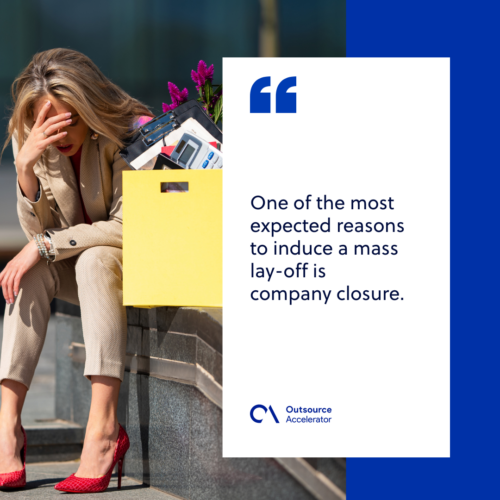Small Business Closing Employee Rights UK: What You Need to Learn About Redundancy
Small Business Closing Employee Rights UK: What You Need to Learn About Redundancy
Blog Article
Exploring the Interplay Between Business Redundancy and Organizational Versatility for Future Growth
In the dynamic landscape these days's company globe, the elaborate partnership between firm redundancy and organizational adaptability becomes an important element for continual growth and success. Business often deal with the challenge of striking a fragile equilibrium between keeping a level of redundancy to alleviate threats and fostering flexibility to react swiftly to the ever-evolving market demands. This delicate interplay holds the crucial to not just making it through in stormy times but additionally thriving when faced with unpredictability. As we explore the diverse measurements of this interaction, interesting understandings into exactly how companies browse these complexities to lead the way for future development wait for.
Relevance of Firm Redundancy
Firm redundancy is an important element that boosts business strength and minimizes functional threats. By including redundancy procedures within the organizational framework, companies can better withstand unexpected interruptions and fluctuations in business environment. Redundancy offers as a strategic barrier, permitting firms to adapt and respond effectively to unexpected obstacles without compromising essential procedures.
One secret facet of the value of business redundancy is its function in guaranteeing continuity throughout times of dilemma. When confronted with sudden changes or emergencies, redundant systems, sources, or workers can action in to maintain crucial features and avoid widespread disturbances. This continuity not only safeguards the firm's track record and client trust yet likewise minimizes economic losses and operational downtime.

Techniques for Business Flexibility

Producing versatile organizational structures that enable for quick modifications to market characteristics and consumer requirements is vital for staying competitive in a rapidly progressing environment. By proactively determining possible disruptions and possibilities, organizations can proactively adapt and prosper in an ever-changing organization landscape.
Harmonizing Redundancy and Adaptability
Attaining an unified stability between functional redundancy and business flexibility is vital in browsing the complexities of a vibrant company setting. Redundancy within a firm provides a safeguard, making sure continuity and stability in operations. Nonetheless, an unwanted of redundancy can lead to ineffectiveness and prevent flexibility to changing market problems. On the various other hand, business flexibility permits companies to react without delay to exterior disruptions and take new chances. Striking the right equilibrium in between redundancy and adaptability is a delicate process that needs a deep understanding of the organization's objectives, industry dynamics, and risk tolerance.
To attain this equilibrium, companies need to explanation perform normal assessments of their procedures to recognize areas where redundancy is required for risk mitigation and where flexibility can drive technology and development. Implementing adaptable structures, fostering a society of constant knowing and enhancement, and urging open interaction across all degrees of the company are essential methods to harmonize redundancy and versatility efficiently. By straightening these 2 critical components, firms can place themselves for sustainable development and success in an ever-changing company landscape.
Situation Studies on Adaptation Success
In checking out circumstances of successful organizational adjustment, it becomes evident that the interaction between operational redundancy and adaptability is a defining element in shaping resistant services. One engaging case research study is that of Netflix. At first a DVD rental service, Netflix showed impressive flexibility by transitioning right into a streaming platform when digitalization interrupted the market. By purposefully spending in innovation and content production, Netflix not just prospered but endured in a rapidly evolving market. An additional standout example is Amazon. Starting as an online bookstore, Amazon constantly adapted its organization design, expanding into varied fields such as cloud browse around this site computer and artificial intelligence. This flexibility permitted Amazon to stay in advance of rivals and meet transforming consumer demands. Lastly, Adobe provides a noteworthy image of successful adjustment. The company changed from marketing software application licenses to a subscription-based model, making sure reoccuring income streams and boosted client engagement. These instance researches emphasize the relevance of functional redundancy combined with organizational adaptability in promoting long-term growth and competition.
Building Strength for Future Growth
Building durability for future growth calls for a critical placement of functional procedures with market characteristics and emerging trends. Business should adjust to transforming atmospheres by cultivating a society of adaptability, advancement, and continuous renovation.
Moreover, promoting strong partnerships with stakeholders, such as customers, employees, distributors, and the neighborhood, is necessary for maintaining and weathering uncertainties depend on and assistance throughout stormy times. Reliable interaction and transparency play a vital role in building resilience, as they article aid line up expectations and assist in cooperation in browsing uncertainties.
In addition, organizations require to focus on discovering and development campaigns to upskill workers and outfit them with the required devices to adjust to transforming scenarios. By purchasing their labor force, companies can improve their flexibility and agility, inevitably strengthening their strength for lasting future growth.
Conclusion

In the vibrant landscape of today's organization globe, the elaborate partnership in between firm redundancy and organizational adaptability arises as a critical aspect for sustained development and success. Companies typically encounter the difficulty of striking a delicate balance in between preserving a level of redundancy to reduce risks and cultivating adaptability to react swiftly to the ever-evolving market demands.To accomplish this equilibrium, companies need to conduct normal evaluations of their operations to determine locations where redundancy is needed for risk mitigation and where adaptability can drive advancement and growth.In final thought, the interplay between firm redundancy and organizational adaptability is crucial for future development. Structure resilience via a combination of redundancy and adaptability will make certain that firms are prepared for the challenges of the future.
Report this page